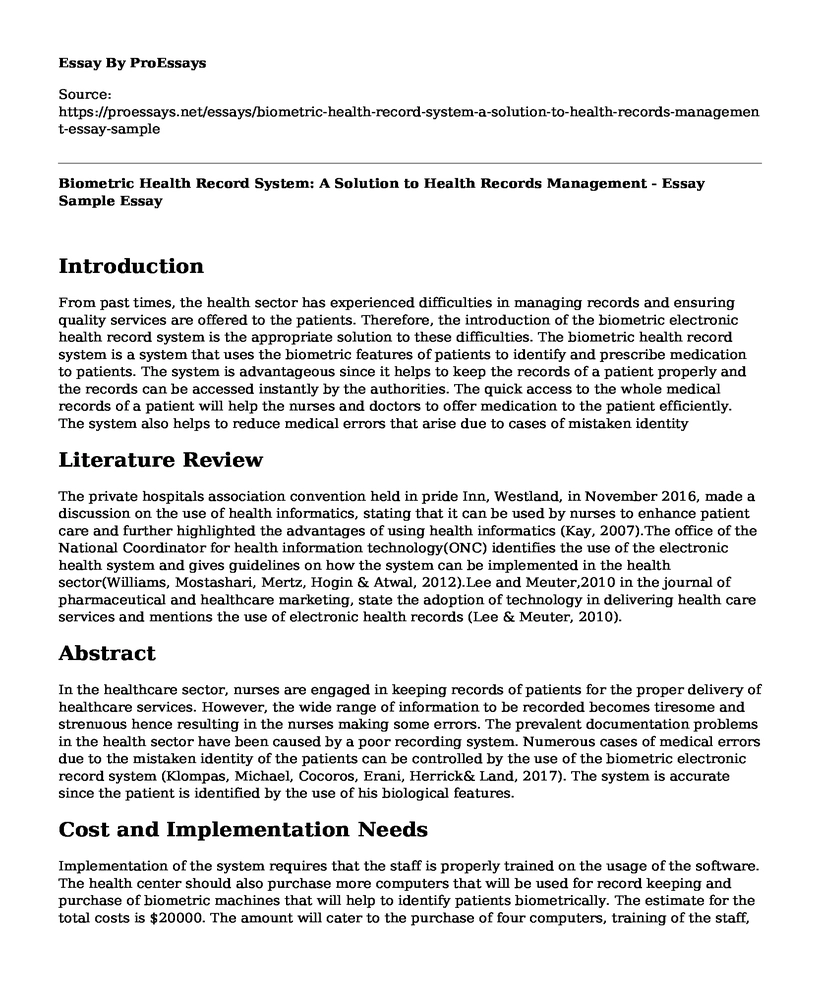Introduction
From past times, the health sector has experienced difficulties in managing records and ensuring quality services are offered to the patients. Therefore, the introduction of the biometric electronic health record system is the appropriate solution to these difficulties. The biometric health record system is a system that uses the biometric features of patients to identify and prescribe medication to patients. The system is advantageous since it helps to keep the records of a patient properly and the records can be accessed instantly by the authorities. The quick access to the whole medical records of a patient will help the nurses and doctors to offer medication to the patient efficiently. The system also helps to reduce medical errors that arise due to cases of mistaken identity
Literature Review
The private hospitals association convention held in pride Inn, Westland, in November 2016, made a discussion on the use of health informatics, stating that it can be used by nurses to enhance patient care and further highlighted the advantages of using health informatics (Kay, 2007).The office of the National Coordinator for health information technology(ONC) identifies the use of the electronic health system and gives guidelines on how the system can be implemented in the health sector(Williams, Mostashari, Mertz, Hogin & Atwal, 2012).Lee and Meuter,2010 in the journal of pharmaceutical and healthcare marketing, state the adoption of technology in delivering health care services and mentions the use of electronic health records (Lee & Meuter, 2010).
Abstract
In the healthcare sector, nurses are engaged in keeping records of patients for the proper delivery of healthcare services. However, the wide range of information to be recorded becomes tiresome and strenuous hence resulting in the nurses making some errors. The prevalent documentation problems in the health sector have been caused by a poor recording system. Numerous cases of medical errors due to the mistaken identity of the patients can be controlled by the use of the biometric electronic record system (Klompas, Michael, Cocoros, Erani, Herrick& Land, 2017). The system is accurate since the patient is identified by the use of his biological features.
Cost and Implementation Needs
Implementation of the system requires that the staff is properly trained on the usage of the software. The health center should also purchase more computers that will be used for record keeping and purchase of biometric machines that will help to identify patients biometrically. The estimate for the total costs is $20000. The amount will cater to the purchase of four computers, training of the staff, and installation of the electronic health system software. The maintenance costs are estimated to be $1000 per month.
Conclusion
The system will immensely reduce the expenditure on data management since the purchase of record books, and paper files will not continue (Flores, Win, & Susilo, 2010).The use of biometrics to identify patients will curb medical errors since each person has unique biological features. Furthermore, the system enhances healthcare coordination since a nurse can access the medical history of a patient and effectively administer the required prescription (Richards, Prybutok & Ryan, 2012).
References
Flores Zuniga, A. E., Win, K. T., & Susilo, W. (2010). Functionalities of free and open electronic health record systems. International Journal of Technology Assessment in Health Care, 26(4), 382-9. doi:http://dx.doi.org/10.1017/S0266462310001121
Klompas, Michael, M.D., M.P.H., Cocoros, Noelle M,D.Sc, M.P.H., Menchaca, J. T., B.S., Erani, D., M.B.A., Hafer, Ellen,M.T.S., M.B.A., Herrick, B., M.D., . . . Land, T., Ph.D. (2017). State and local chronic disease surveillance using electronic health record systems. American Journal of Public Health, 107(9), 1406-1412. doi:http://dx.doi.org/10.2105/AJPH.2017.303874
Lee, O. F., & Meuter, M. L. (2010). The adoption of technology orientation in healthcare delivery: a Case study of a large-scale hospital and healthcare system's electronic health record. International Journal of Pharmaceutical and Healthcare Marketing, 4(4), 355-374. doi:http://dx.doi.org/10.1108/17506121011095209
Richards, R. J., Prybutok, V. R., & Ryan, S. D. (2012). Electronic medical records: Tools for competitive advantage. International Journal of Quality and Service Sciences, 4(2), 120-136. doi:http://dx.doi.org/10.1108/17566691211232873
Williams, C., Mostashari, F., Mertz, K., Hogin, E., & Atwal, P. (2012). From the office of the national coordinator: The strategy for advancing the exchange of health information. Health Affairs, 31(3), 527-36.
Kay, M. J. (2007). Healthcare marketing: What is salient? International Journal of Pharmaceutical and Healthcare Marketing, 1(3), 247-263. doi:http://dx.doi.org/10.1108/17506120710818256
Cite this page
Biometric Health Record System: A Solution to Health Records Management - Essay Sample. (2023, Feb 27). Retrieved from https://proessays.net/essays/biometric-health-record-system-a-solution-to-health-records-management-essay-sample
If you are the original author of this essay and no longer wish to have it published on the ProEssays website, please click below to request its removal:
- Paper Example on Maternal and Fetal Death after Dengue Infection: Insights on Dengue Diagnosis
- Group Protocol Assignment: Dealing With Physical Disability in Older Adults in the Long-Term Rehab
- Is Weight Loss Maintenance Possible? - Essay Sample
- Essay on AACN Research Results: Diabetes and Cancer Rate Increase With Globalization
- Importance of Ensuring That Others Are Aware of Own Whereabouts
- Essay Example on Older Adults in America: Healthcare Utilization and Accessibility
- Free Essay Example on Breast Cancer







